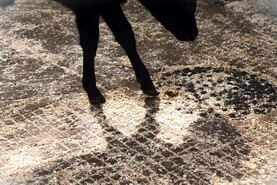The whole herd performance recording (WHPR) programme was set up in autumn 2016 by the ICBF as a way of allowing pedigree breeders to get their animals independently weighed and scored by the ICBF. This data all feeds back into the system to help increase the reliability figure behind the €uro-Star indices of animals.
By having this data coming in from an independent source, the data collected through the programme offers the truest reflection of where our pedigree herd stands in relation to key data such as birth weights, weanling weights and mature cow weights.
The programme assesses all animals on the farm when visited, this helps vastly in improving data collection compared with the previous programme which in a lot of cases only saw one or two animals scored per visit.
The programme currently has 630 members across 12 breeds. Some breeders have fully backed the programme, seeing as high as 60% of their cow population assessed. Overall across all breeds, 20% of all pedigree cows have been assessed in the programme.
Data quality and quantity is the key behind driving the improvement of genetic evaluations.
This is why it is essential for breeders to input as much data as possible. This is particularly relevant for the Irish pedigree sector which has a number of challenges. Firstly, the average herd size for Irish pedigree herds is much smaller than that of other countries. Each farm is a different environment. No farm is the same as the next, which means each contemporary group has to be looked at individually.
This is further complicated given the vast number of sires used across the board. Approximately 4,500 sires are used in the national pedigree herd population of 38,500. To break this down, it means each sire used produces an average of nine calves per year. This shows just how vital data collection is at all stages of these animals’ lives. Otherwise, a sire used sparingly may have no progeny data contributing to his overall €uro-Star index.
The figures
Looking over the tables, we see that average birth weight between breeds varies from 38kg to 50kg in bulls and 36kg to 47kg for heifers.
In both bulls and heifers, the Charolais breed recorded the highest average birth weight while the Angus breed recorded the lowest.
We also see charts with weight figures for bulls and heifers between 100 and 250 days. These figures give a good reflection of early growth rate, as well as the dam’s milking ability.
As each breed has a different birth weight and different average age, we have combined the figures to work out one average daily gain figure.
Here, we see that bulls across all breeds averaged 1.16kg/day at an average age of six months. At a similar age, across breeds, female calves averaged just over the 1kg/day.
Topping the average daily gain for both bulls and heifers was the Simmental breed.
The breed saw bulls average at 1.4kg/day, while the heifers averaged 1.26kg/day.
It must be noted, however, that the Simmental breed is working off a much smaller population than some of the other major breeds.
While average daily gain gives a reflection of growth and milking ability of the dam in early life, it doesn’t necessarily mean that they are the highest performing. While weight gain may be high, these animals may need a lot more feed to put on that weight.
A better reflection would be feed conversion efficiency (FCI) or residual average daily gain (ADG).
FCI takes into account how much weight the animal is putting on from the given intake, while ADG works the actual gain off a predicted gain based on intake and body weight.
However, these trials are generally undertaken when the animal is old and off the dam, as intake measurement is easier to gather.






 This is a subscriber-only article
This is a subscriber-only article









SHARING OPTIONS: